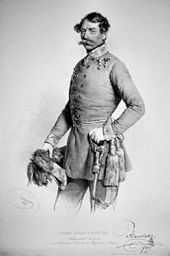Franz von Hauslab



Franz Edler von Hauslab , from 1850: Franz Ritter von Hauslab (born February 1, 1798 in Vienna ; † February 11, 1883 ibid) was an old Austrian general and cartographer . In 1849 he received the Knight's Cross of the Military Maria Theresa Order .
Life
Franz von Hauslab was the son of the Austrian officer, miniature painter and drawing teacher Franz Edler von Hauslab (1749-1820). He studied at the engineering academy, took part in the campaign in France in 1815 as an ensign and was accepted into the quartermaster's staff in 1816 .
From 1827 to 1830 von Hauslab belonged to the embassy in Constantinople and acted as an instructor for the Turkish officers sent to Vienna for training . As a captain and major , he was also the educator of Archduke Albrecht , in 1843 a teacher of the future Emperor Franz Joseph I and his brother Archduke Ferdinand Maximilian .
In 1848, as major general , he commanded the artillery during the siege of Vienna. In 1849 he was awarded the Knight's Cross of the Military Maria Theresa Order for leading the artillery of the imperial main army under FZM Haynau in the battle of Szöreg (August 5) and Temesvár (August 9) .
Hauslab then served as General Artillery Director from 1854 to 1860 and as head of the War Ministry's scientific committee from 1860 to 1865 . In 1868 he went into permanent retirement as a Feldzeugmeister .
As a cartographer, among other things, he created the color scale for the contour lines in maps. In 1826 he introduced color lithography to cartography . He also dealt with geological studies. Von Hauslab owned an important library and art collection, which he bequeathed to his nurse (from 1884 wife of Theodor von Hörmann , 1840–1895), Laura Bertuch (* 1842), and that of the ruling Prince Johann II of Liechtenstein in July 1883 was purchased.
Works (selection)
- Depiction of the Imperial and Royal Austrian Army with all its batches, including an appendix containing the military music gangs, artillery clothing, navy and all military trains , 1822–1825 by Josef Trentsensky, lithographs by Joseph Kriehuber . (New edition: Edition Tusch , Vienna 1975)
literature
- Constantin von Wurzbach : Hauslab, Franz Ritter von . In: Biographisches Lexikon des Kaiserthums Oesterreich . 8th part. Kaiserlich-Königliche Hof- und Staatsdruckerei, Vienna 1862, pp. 90–92 ( digitized version ).
- Oscar Criste: Hauslab, Franz Ritter von . In: Allgemeine Deutsche Biographie (ADB). Volume 50, Duncker & Humblot, Leipzig 1905, pp. 81-83.
- Meyers Konversations-Lexikon , sixth edition, 1905.
- Jan Mokre: Franz Ritter von Hauslab: The learned officer , series of publications by the Heeresgeschichtliches Museum , Volume 25, Vienna 2018, ISBN 978-3-902551-83-2
- Wolfgang von Wurzbach: Josef Kriehuber and the Vienna Society of his Time , Volume II, Walter Krieg Verlag Vienna, 1957.
- House lab Franz von. In: Austrian Biographical Lexicon 1815–1950 (ÖBL). Volume 2, Verlag der Österreichischen Akademie der Wissenschaften, Vienna 1959, p. 221.
- Nikolaus von Preradovich : Hauslab, Franz Ritter von. In: New German Biography (NDB). Volume 8, Duncker & Humblot, Berlin 1969, ISBN 3-428-00189-3 , p. 122 f. ( Digitized version ).
Individual evidence
- ↑ Army Courier. In: Austrian soldier friend. Journal for Military Interests , No. 39/1850 (3rd volume), March 30, 1850, p. 174, bottom right. (Online at ANNO ). .
- ^ A b Ferdinand Anders : From Schönbrunn and Miramar to Mexico. Life and work of the Archduke Emperor Ferdinand Maximilian . Academic Printing and Publishing Company, Graz 2009, ISBN 978-3-201-01899-9 , S, 17.
- ^ The will of the FZM. House lab. In: Neue Freie Presse , Abendblatt, No. 6632/1883, February 13, 1883, p. 2, top right. (Online at ANNO ). .
- ↑ American Congress on Surveying and Mapping (Ed.): Proceedings of the American Congress on Surveying and Mapping (...) annual Meeting . Volume 36. 1976, Washington (DC) 1976, ZDB -ID 774783-4 , p. 206.
| personal data | |
|---|---|
| SURNAME | Hauslab, Franz von |
| ALTERNATIVE NAMES | Hauslab, Franz Ritter von |
| BRIEF DESCRIPTION | Austrian general and cartographer |
| DATE OF BIRTH | February 1, 1798 |
| PLACE OF BIRTH | Vienna |
| DATE OF DEATH | February 11, 1883 |
| Place of death | Vienna |
